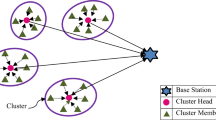Abstract
Wireless sensor network comprises of tiny devices which are powered by limited energy resources. Therefore, providing methods to reduce energy consumption is essential to develop this sort of networks. Clustering is one of the major techniques which is introduced to increase wireless sensor network lifetime through providing hierarchy structure. This article represents a semi-distributed fuzzy algorithm to cluster homogeneous nodes by using virtual grids in wireless sensor networks. First phase of FSCVG clustering includes selecting the initial cluster heads and determining virtual grids which are done in a centralized approach by the base station. The second phase follows a distributed approach, as all of the nodes involve in the cluster head selection process. FSCVG uses remaining energy, distance to base station and centrality as the fuzzy logic parameters to select the cluster heads in both phases. FSCVG utilizes multi-hop cluster based routing and also an adaptive threshold with the aim of prolonging of network lifetime. FSCVG algorithm is compared to other methods in five scenarios. The assessment criteria used in the comparison include the network remaining energy, the number of dead nodes, the first dead node, half of dead nodes and the last dead node. The results show that proposed algorithm could reduce network energy consumption and prolong network lifetime.




























Similar content being viewed by others
References
Lin, H., Wang, L., & Kong, R. (2015). Energy efficient clustering protocol for large-scale sensor networks. IEEE Sensors Journal, 15(12), 7150–7160.
Elhoseny, M., Farouk, A., Zhou, N., Wang, M. M., Abdalla, S., & Batle, J. (2017). Dynamic multi-hop clustering in a wireless sensor network: Performance improvement. Wireless Personal Communications, 95(4), 3733–3753.
Nayak, P., & Devulapalli, A. (2015). A fuzzy logic-based clustering algorithm for WSN to extend the network lifetime. IEEE Sensors Journal, 16(1), 137–144.
WohweSambo, D., Yenke, B. O., Förster, A., & Dayang, P. (2019). Optimized clustering algorithms for large wireless sensor networks: A review. Sensors, 19(2), 322.
Yenke, B. O., Sambo, D. W., Ari, A. A. A., & Gueroui, A. (2016). MMEDD: Multithreading model for an efficient data delivery in wireless sensor networks. International Journal of Communication Networks and Information Security, 8(3), 179.
Fanian, F., & Rafsanjani, M. K. (2019). Cluster-based routing protocols in wireless sensor networks: A survey based on methodology. Journal of Network and Computer Applications, 142, 111–142.
Bagci, H., & Yazici, A. (2010). An energy aware fuzzy unequal clustering algorithm for wireless sensor networks. In International conference on fuzzy systems (pp. 1–8). IEEE.
Harizan, S., & Kuila, P. (2020). Evolutionary algorithms for coverage and connectivity problems in wireless sensor networks: A study. In: Design frameworks for wireless networks (pp. 257–280). Springer, Singapore
Phoemphon, S., So‑In, C., Aimtongkham, P., & Nguyen, T. G. (2020). An energy-efficient fuzzy-based scheme for unequal multihop clustering in wireless sensor networks. Journal of Ambient Intelligence and Humanized Computing. https://doi.org/10.1007/s12652-020-02090-z.
Afsar, M. M., & Younis, M. (2019). A load-balanced cross-layer design for energy-harvesting sensor networks. Journal of Network and Computer Applications, 145, 102390.
Zhang, J., Feng, X., & Liu, Z. (2018). A grid-based clustering algorithm via load analysis for industrial Internet of things. IEEE Access, 6, 13117–13128.
Lalitha, K., Thangarajan, R., Udgata, S. K., Poongodi, C., & Sahu, A. P. (2017). GCCR: An efficient grid based clustering and combinational routing in wireless sensor networks. Wireless Personal Communications, 97(1), 1075–1095.
Zhou, Y., Wang, N., & Xiang, W. (2016). Clustering hierarchy protocol in wireless sensor networks using an improved PSO algorithm. IEEE Access, 5, 2241–2253.
Heinzelman, W. B., Chandrakasan, A. P., & Balakrishnan, H. (2002). An application-specific protocol architecture for wireless microsensor networks. IEEE Transactions on Wireless Communications, 1(4), 660–670.
Moussa, N., Hamidi-Alaoui, Z., & El Alaoui, A. E. B. (2020). ECRP: An energy-aware cluster-based routing protocol for wireless sensor networks. Wireless Networks,. https://doi.org/10.1007/s11276-019-02247-5.
Javaid, N., Rasheed, M. B., Imran, M., Guizani, M., Khan, Z. A., Alghamdi, T. A., & Ilahi, M. (2015). An energy-efficient distributed clustering algorithm for heterogeneous WSNs. EURASIP Journal on Wireless Communications and Networking, 2015(1), 1–11.
Lee, J. S., & Kao, T. Y. (2016). An improved three-layer low-energy adaptive clustering hierarchy for wireless sensor networks. IEEE Internet of Things Journal, 3(6), 951–958.
Cenedese, A., Luvisotto, M., & Michieletto, G. (2016). Distributed clustering strategies in industrial wireless sensor networks. IEEE Transactions on Industrial Informatics, 13(1), 228–237.
Das, S. K., & Tripathi, S. (2019). Energy efficient routing formation algorithm for hybrid ad-hoc network: A geometric programming approach. Peer-to-Peer Networking and Applications, 12(1), 102–128.
Sert, S. A., Bagci, H., & Yazici, A. (2015). MOFCA: Multi-objective fuzzy clustering algorithm for wireless sensor networks. Applied Soft Computing, 30, 151–165.
Baranidharan, B., & Santhi, B. (2016). DUCF: Distributed load balancing unequal clustering in wireless sensor networks using fuzzy approach. Applied Soft Computing, 40, 495–506.
Akila, I. S., & Venkatesan, R. (2016). A cognitive multi-hop clustering approach for wireless sensor networks. Wireless Personal Communications, 90(2), 729–747.
Balakrishnan, B., & Balachandran, S. (2017). FLECH: Fuzzy logic based energy efficient clustering hierarchy for nonuniform wireless sensor networks. Wireless Communication Mobile Computing, 2017, 1214720.
Agrawal, D., & Pandey, S. (2018). FUCA: Fuzzy-based unequal clustering algorithm to prolong the lifetime of wireless sensor networks. International Journal of Communication Systems, 31(2), e3448.
Mazumdar, N., & Om, H. (2017). Distributed fuzzy logic based energy-aware and coverage preserving unequal clustering algorithm for wireless sensor networks. International Journal of Communication Systems, 30(13), e3283.
Mazinani, A., Mazinani, S. M., & Mirzaie, M. (2019). FMCR-CT: An energy-efficient fuzzy multi cluster-based routing with a constant threshold in wireless sensor network. Alexandria Engineering Journal, 58(1), 127–141.
Author information
Authors and Affiliations
Corresponding author
Additional information
Publisher's Note
Springer Nature remains neutral with regard to jurisdictional claims in published maps and institutional affiliations.
Rights and permissions
About this article
Cite this article
Mazinani, A., Mazinani, S.M. & Hasanabadi, S. FSCVG: A Fuzzy Semi-Distributed Clustering Using Virtual Grids in WSN. Wireless Pers Commun 118, 1017–1038 (2021). https://doi.org/10.1007/s11277-020-08056-w
Accepted:
Published:
Issue Date:
DOI: https://doi.org/10.1007/s11277-020-08056-w




